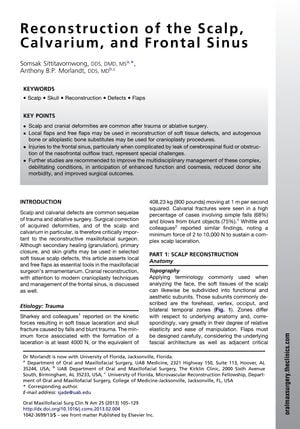Reconstruction of the Scalp, Calvarium, and Frontal Sinus
May 2013
in “
Oral and Maxillofacial Surgery Clinics of North America
”
scalp reconstruction calvarium reconstruction frontal sinus reconstruction local flaps free flaps microvascular techniques anterolateral thigh flap ALT flap autogenous bone grafts membranous bones alloplastic materials titanium plates polymethylmethacrylate PMMA cranioplasty frontal sinus fractures cranialization CSF leakage bone grafts

TLDR The document concludes that careful surgical methods and choosing the right materials are key for successful scalp, skull, and frontal sinus reconstruction.
The document from May 1, 2013, reviews surgical techniques and materials for reconstructing the scalp, calvarium, and frontal sinus after trauma or surgery. It discusses the use of local and free flaps for soft tissue defects, with microvascular techniques having up to a 92% success rate for scalp defects. The anterolateral thigh (ALT) flap is highlighted for its advantages in scalp reconstruction. For cranial reconstruction, autogenous bone grafts are preferred, particularly from membranous bones. Alloplastic materials like titanium plates and polymethylmethacrylate (PMMA) are also discussed for cranioplasty. Frontal sinus fractures, which occur in about 8% of automobile accidents, may require conservative treatment or more complex procedures like cranialization, depending on the extent of damage and CSF leakage. The document emphasizes the need for meticulous surgical technique and appropriate material choice for successful outcomes and calls for further studies to improve the multidisciplinary management of these conditions.
